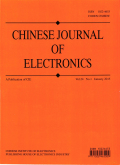- 钛学术文献服务平台 \
- 学术期刊 \
- 工业技术期刊 \
- 无线电电子学与电信技术期刊 \
- 中国电子杂志(英文版)期刊 \
A Fast Feature Extraction Method Based on Integer Wavelet Transform for Hyperspectral Images
A Fast Feature Extraction Method Based on Integer Wavelet Transform for Hyperspectral Images
基本信息来源于合作网站,原文需代理用户跳转至来源网站获取
摘要:
Hyperspectral remote sensing provides high-resolution spectral data and the potential for remote discrimination between subtle differences in ground covers. However, the high-dimensional data space generated by the hyperspectral sensors creates a new challenge for conventional spectral data analysis techniques. A challenging problem in using hyperspectral data is to eliminate redundancy and preserve useful spectral information for applications. In this paper, a Fast feature extraction (FFE) method based on integer wavelet transform is proposed to extract useful features and reduce dimensionality of hyperspectral images. The FFE method can be directly used to extract useful features from spectral vector of each pixel resident in the hyperspectral images. The FFE method has two main merits: high computational efficiency and good ability to extract spectral features. In order to better testify the effectiveness and the performance of the proposed method, classification experiments of hyperspectral images are performed on two groups of AVIRIS (Airborne visible/infrared imaging spectrometer) data respectively. In addition, three existing methods for feature extraction of hyperspectral images, i.e. PCA, SPCT and Wavelet Transform, are performed on the same data for comparison with the proposed method. The experimental investigation shows that the efficiency of the FFE method for feature extraction outclasses those of the other three methods mentioned above.

推荐文章
Rapid estimation of soil heavy metal nickel content based on optimized screening of near-infrared sp
Heavy metal
Band extraction
Partial least squares regression
Extreme learning machine
Near infrared spectroscopy
Rapid and sensitive method for determining free amino acids in plant tissue by high-performance liqu
HPLC
OPA
FMOC
Free amino acids
Plant
PLS-DA
Hyperspectral estimation model of soil Pb content and its applicability in different soil types
Hyperspectral data
Heavy metal
Pb
Estimation
内容分析
关键词云
关键词热度
相关文献总数
(/次)
(/年)
引文网络
引文网络
二级参考文献 (0)
共引文献 (0)
参考文献 (0)
节点文献
引证文献 (0)
同被引文献 (0)
二级引证文献 (0)
2004(0)
- 参考文献(0)
- 二级参考文献(0)
- 引证文献(0)
- 二级引证文献(0)
研究主题发展历程
节点文献
特征提取
整数小波变换
图像处理
超谱图像
研究起点
研究来源
研究分支
研究去脉
引文网络交叉学科
相关学者/机构
期刊影响力
中国电子杂志(英文版)
主办单位:
出版周期:
季刊
ISSN:
1022-4653
CN:
N
开本:
出版地:
北京165信箱
邮发代号:
创刊时间:
语种:
eng
出版文献量(篇)
1919
总下载数(次)
1
总被引数(次)
318
期刊文献
相关文献
推荐文献
- 期刊分类
- 期刊(年)
- 期刊(期)
- 期刊推荐
一般工业技术
交通运输
军事科技
冶金工业
动力工程
化学工业
原子能技术
大学学报
建筑科学
无线电电子学与电信技术
机械与仪表工业
水利工程
环境科学与安全科学
电工技术
石油与天然气工业
矿业工程
自动化技术与计算机技术
航空航天
轻工业与手工业
金属学与金属工艺
中国电子杂志(英文版)2019
中国电子杂志(英文版)2015
中国电子杂志(英文版)2013
中国电子杂志(英文版)2012
中国电子杂志(英文版)2011
中国电子杂志(英文版)2010
中国电子杂志(英文版)2009
中国电子杂志(英文版)2008
中国电子杂志(英文版)2007
中国电子杂志(英文版)2006
中国电子杂志(英文版)2005
中国电子杂志(英文版)2004
中国电子杂志(英文版)2003
中国电子杂志(英文版)2001

 免费查重
免费查重










